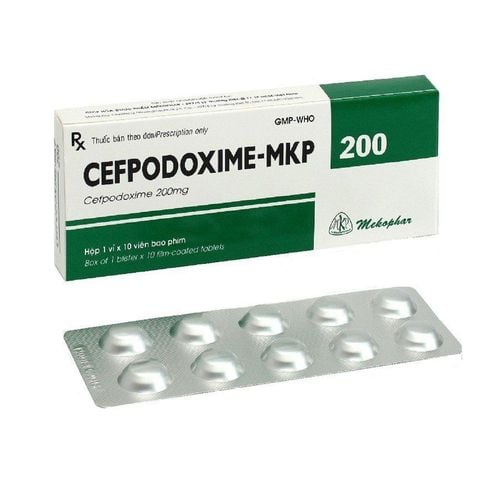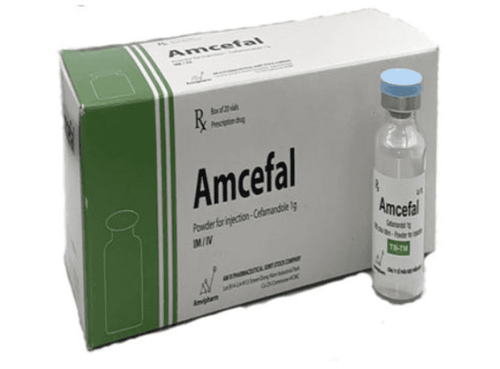This is an automatically translated article.
Cipogip 500 Tablet belongs to the group of antiparasitic, anti-infective, anti-viral, anti-fungal drugs with the composition Ciprofloxacin 500mg. Cipogip 500 Tablet is used to treat patients with respiratory, ENT, kidney or urinary tract infections, including gonorrhea, gastrointestinal diseases, bile ducts, soft tissues, bones and joints...1. Uses of Cipogip 500 Tablet
Cipogip 500 Tablet contains the main ingredient is Ciprofloxacin (Ciprofloxacin hydrochloride form) 500mg, other active ingredients and excipients in sufficient quantity. Ciprofloxacin is a semi-synthetic, broad-spectrum, quinolone antibiotic, also known as DNA girase inhibitors. The drug then blocks the replication of chromosomes, preventing the bacteria from reproducing as quickly. Because of its specificity, ciprofloxacin is not susceptible to parallel resistance to other antibiotics that are not gynase inhibitors. Ciprofloxacin has good effects against bacteria resistant to antibiotics of other groups (such as Aminoglycosides, Cephalosporins, Tetracyclines, Penicillins...).
Therefore, Cipogip 500 is indicated for severe infections caused by susceptible bacteria in cases such as:
Respiratory tract infections; Infections of the middle ear (otitis media) and the sinuses (sinusitis), especially caused by gram-negative bacteria including pseudomonas or staphylococcus; Kidney and urinary tract infections caused by bacteria Escherichia coli, Klebsiella pneumoniae, Enterobacter cloacae, Serratia marcescens, Proteus mirabilis, Providencia rettgeri, Morganella morganii, Citrobacter diversus, Citrobacter freundii, Pseudomonas aeruginosa, Staphylococcus epidermiecalis and Streptococcus spp. Infections of the genital organs: gonorrhea, adnexitis and prostatitis ; Abdominal infections; Skin and soft tissue infections caused by Escherichia coli, Klebsiella pneumoniae, Enterobacter cloacae, Proteus mirabilis, Proteus vulgaris, Providencia stuartii, Morganella morganii, Citrobacter freundii, Pseudomonas aeruginosa, Staphylococcus aureus, Staphyloceccus epidermidis and Streptococcus pyogenes; Bone and joint infections; Sepsis ; Infection or risk of infection (prophylaxis) in immunocompromised patients (immune-compromised or neutropenic patients); Enteric infections in immunocompromised patients. Cipogip 500 Tablet is contraindicated in the following subjects:
Patients with a history of hypersensitivity to Ciprofloxacin and other related drugs such as nalidixic acid or other Quinolones or any of its ingredients; Pregnant or lactating women; Children and young children; Patients with epilepsy ; The patient has a history of tendon rupture or tendinitis.
2. How to use and dosage of Cipogip 500 Tablet
How to use:
Cipogip 500 Tablet in the form of film-coated tablets should be used orally. For rapid absorption of Cipogip 500, it should be taken 2 hours after meals. Patients should regularly drink plenty of water and do not take stomach antacids within 2 hours after taking Cipogip 500 Tablet. Dosage:
Respiratory infections (depending on the severity and amount of bacteria): 250-500mg / time x 2 times / day. Urinary tract infections: Acute and uncomplicated: 125-250mg/time x 2 times/day; Cystitis in women (premenopausal): 250mg single dose; Complications: 250-500mg/time x 2 times/day; In urinary tract infections caused by Chlamydia: In case of need, the daily dose should be increased to 750mg/time x 2 times/day. Gonorrhea: Outside the genitals: 125mg/time x 2 times/day; Acute or uncomplicated: 250mg single dose; Other infections: 500mg/time x 2 times/day; Serious, possibly life-threatening, infections such as: Streptococcal pneumonia, recurrent infections in cystic fibrosis, bone and joint infections, bacteremia, peritonitis, especially due to Pseudomonas, Staphylococeus or Streptococcus: 750mg/ times x 2 times/day. Note: For doses below 500mg, refer to other 100mg, 150mg, 200mg, 300mg, 400mg tablets of the same active ingredient Ciprofloxacin as Cipogip 500 Tablet for the most effective dose.
3. Unintended effects of Cipogip 500 Tablet
During the treatment with Cipogip 500 Tablet, users may experience unwanted effects. Most of the side effects of the drug are on the stomach - intestines, central nervous system and skin:
Common (> 1%): Nausea, vomiting, diarrhea, abdominal pain; Temporarily increased levels of transaminases. Uncommon (0.1% < ADR < 1%): Drug-induced headache or fever; Eosinophilia, lymphocytopenia, polymorphonuclear leukopenia, anemia and thrombocytopenia; Fast heart beat; agitation; Digestive disorders; Rash, pruritus, superficial phlebitis; Temporary increase in bilirubin, creatinine and alkaline phosphatase in the blood; Pain in joints, joint swelling. Rare (ADR < 0.1%): Anaphylactic or anaphylactoid reactions; Hemolytic anemia, increased leukocytes and platelets, changes in prothrombin levels; Convulsions, paranoia, insomnia, confusion, depression, peripheral psychopathy, visual disturbances including hallucinations, hearing disturbances, psychosis, tinnitus, taste and smell disturbances sensation, increased intracranial pressure; Pseudomembranous colitis; Skin-mucosal syndrome, vasculitis, Lyell's syndrome, erythema nodosum, erythema multiforme exudate; Possible hepatocellular necrosis, hepatitis and cholestatic jaundice; Muscle pain or inflammation of the tendon (heel tendon) and surrounding tissue. There are cases of tendon rupture, especially in the elderly when used with corticosteroids; Crystalluria occurs when urine is alkaline, hematuria, acute renal failure and interstitial nephritis; Sensitivity to light during sun exposure, laryngeal or pulmonary edema, dyspnea and bronchospasm.
4. Pay attention when using Cipogip 500 Tablet
Long-term use of Cipogip 500 Tablet may cause overgrowth of bacteria that are not sensitive to the drug. It is necessary to monitor the patient and make a regular antibiotic chart for appropriate treatment; Cipogip 500 may cause tests for Mycobacterium tuberculosis to be false negative; Cipogip 500 Tablet is not recommended for young children and growing children (the drug can cause cartilage degeneration in weight-bearing joints); Using Cipogip 500 Tablet may cause dizziness, lightheadedness, dizziness and affect the ability to drive or operate machinery. Even when taking the drug according to the instructions for use, Cipogip 500 can still affect the reaction speed, especially when using alcohol or alcoholic beverages; It should be used with caution in people with severe renal impairment, hemodynamic disorders or the elderly. Stop taking the drug when there are symptoms of pain, inflammation, tendon rupture; Avoid use during pregnancy, because Cipogip 500 Tablet may cause joint disease in animal studies should be replaced with safer drugs if available; Cipogip 500 medicine will pass to the baby through breast milk, so it should not or be limited to taking this medicine while breastfeeding.
5. Drug interactions of Cipogip 500 Tablet
Co-administration with non-steroidal anti-inflammatory drugs (Ibuprofen, Indomethacin...) may increase the side effects of Cipogip 500 Tablet; Co-administration of Cipogip 500 with aluminum and magnesium antacids has the potential to reduce serum concentrations and bioavailability of Ciprofloxacin; Cipogip 500 should not be taken at the same time with anti-acid drugs, it is necessary to take the drugs apart (should take the anti-acid drug 2-4 hours before taking Cipogip 500 Tablet) but the drug still does not achieve the optimal effect; The absorption of Ciprofloxacin will be halved if used with some cytotoxic drugs (such as Cyclophosphamide, Vincristin, Doxorubicin, Cytosin Arabinoside, Mitozantron); If taken concomitantly with Didanosin, the concentration of Ciprofloxacin will be significantly reduced. Therefore, Cipogip 500 should be taken 2 hours before Didanosin or 6 hours after. Preparations with iron (fumarat, gluconate, sulfate) can significantly reduce the absorption of ciprofloxacin from the intestine. Preparations with zinc have less of an effect. Concomitant administration of ciprofloxacin with iron or zinc preparations should be avoided and these drugs should be taken as far apart as possible. Concomitant administration of sucralfate can significantly reduce the absorption of ciprofloxacin. Cipogip 500 Tablet should be given 2 - 6 hours before taking Sucralfate. Concomitant use of Cipogip 500 with Theophylline may also increase the serum concentration of Theophylline, increasing the risk of Theophylline side effects. It is necessary to check the concentration of Theophylline in the blood, reduce the dose in case of forced use of 2 drugs. Ciprofloxacin in Cipogip 500 Tablet and Ciclosporin used concurrently may cause an increase in serum creatinine. Blood creatinine should be checked twice a week. Probenecid reduces glomerular filtration rate and tubular secretion, and it will decrease urinary excretion if the two drugs are taken together. Warfarin when combined with ciprofloxacin can cause hypoprothrombin. It is necessary to regularly check blood prothrombin and adjust the dose of anticoagulants. Above is information about uses, dosage and precautions when using Cipogip 500 Tablet. To ensure safety for your health and maximize the effectiveness of your treatment, you need to take Cipogip 500 Tablet exactly as directed by your doctor.
Please dial HOTLINE for more information or register for an appointment HERE. Download MyVinmec app to make appointments faster and to manage your bookings easily.













